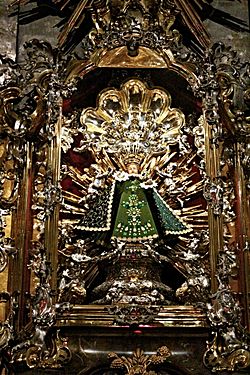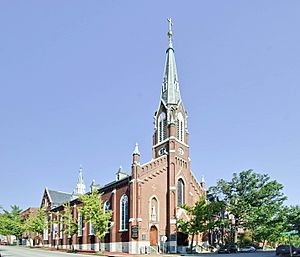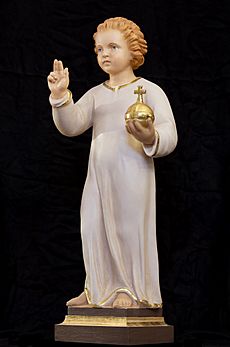Infant Jesus of Prague facts for kids
Quick facts for kids Infant Jesus of Prague Gratiosus Jesulus Pragensis Pražské Jezulátko, Santo Niño de Praga, Divino Menino Jesus, Prager Jesulein |
|
|---|---|

The image wearing its ordinary green vestment along with its present canonical crown.
|
|
| Location | Prague, Czech Republic |
| Date | 1556 |
| Witness | Teresa of Ávila María Manrique de Lara y Mendoza Princess Polyxena of Lobkowicz |
| Type | Wax coated wooden statue with wooden base and silver erector |
| Approval | Pope Leo XII Pope Pius X Pope Pius XI Pope Benedict XVI |
| Shrine | Church of Our Lady of Victories |
The Infant Jesus of Prague (Czech: Pražské Jezulátko) is a famous 16th-century statue of Jesus as a child. It is made of wood covered in wax and shows the Child Jesus holding a special orb called a globus cruciger, which has a cross on top. This statue came from Spain and is now kept in the Discalced Carmelite Church of Our Lady of Victories in Prague, Czech Republic.
The statue first appeared in 1556. Old stories say that the statue once belonged to Teresa of Ávila, a famous saint. Later, in 1628, Princess Polyxena of Lobkowicz gave the statue to the Carmelite friars.
The Carmelite nuns often dress the statue in beautiful clothes, including fancy fabrics, royal decorations, and a golden crown. The statue's left hand holds the globus cruciger, and its right hand is raised in a blessing gesture. People honor the statue on Christmas and on the first Sunday of May. This special Sunday celebrates the statue's 100th year and its "episcopal coronation" in 1655.
Several popes have shown special respect for the Infant Jesus of Prague. Pope Leo XII was the first to officially approve its "canonical coronation" in 1824. This was a very important honor for a statue of Christ. Later, in 1913, Pope Pius X allowed a special group, called a confraternity, to be formed to honor the Infant Jesus.
In 2009, Pope Benedict XVI visited Prague and crowned the statue again. The statue and its caretakers will celebrate 200 years since its first papal crowning in 2024.
Contents
The Statue's Journey
The exact start of the Infant Jesus statue is not fully known. Some history suggests it might be linked to a 19-inch sculpture from Spain, carved around 1340. Many other statues of the Holy Child were made by skilled artists across Europe in the Middle Ages. Sometimes, these statues included a bird, which could mean a soul or the Holy Spirit. The statues were often dressed in royal clothes, showing the fancy styles of that time.
One story says that a monk in a monastery in Spain had a vision of a little boy. The boy told him to pray. After praying for hours, the monk created a figure of the child.
The House of Habsburg began to rule the Kingdom of Bohemia in 1526. This led to close connections between Bohemia and Spain. The Infant Jesus statue first arrived in Bohemia in 1556. It was brought by María Maximiliana Manriquez de Lara y Mendoza when she married a Czech nobleman. An old family story says that María's mother received the statue from Teresa of Ávila herself. María got the statue as a wedding gift. In 1587, she gave it to her daughter, Polyxena of Lobkowicz, also as a wedding gift.
In 1628, Princess Polyxena von Lobkowicz gave the statue to the Carmelite friars, who were quite poor. When she gave it to them, she reportedly said, "Venerable Fathers, I bring you my dearest possession. Honor this image and you shall never be poor.”
The statue was placed in the monastery's prayer room, where special prayers were offered to Jesus twice a day. The new Carmelite members made their promise of poverty in front of the statue. When Emperor Ferdinand II heard about the Carmelites' prayers and needs, he sent them money and a monthly payment to help them.
In 1630, the Carmelite training center moved to Munich. The Thirty Years' War caused problems in Bohemia. On November 15, 1631, the army of King Gustavus Adolphus of Sweden took over Prague. The Carmelite monastery was robbed, and the Infant Jesus statue was thrown into a pile of trash behind the altar. It stayed there forgotten for seven years. Its hands were broken off.
In 1637, Father Cyrillus found the statue again and placed it back in the church's prayer room. One day, while praying before the statue, Cyrillus said he heard a voice. The voice said, "Have pity on me, and I will have pity on you. Give me my hands, and I will give you peace. The more you honor me, the more I will bless you."
Since then, the statue has stayed in Prague. Many people from all over the world come to honor the Holy Child. Many people have said they received blessings, favors, and even miraculous healings after praying to the Infant Jesus.
In 1739, the Carmelites in Austria started a special devotion to the statue. In 1741, the statue was moved to a different side of the Church of Our Lady of Victories in Prague.
Copies of the Infant Jesus statue arrived in Poland in 1680. It became popular in Polish homes and in Bohemia. These copies are often placed in glass cases. After the 17th century, the statue's popularity spread to Christian communities in South Africa, Australia, the Caribbean, Thailand, and Sri Lanka.
What the Statue Looks Like
The statue is 19 inches (48 cm) tall. It shows the Infant Jesus carved from wood. The wood is covered with linen, and the surface is shaped with colored wax. The wax surface is very delicate. To protect it, the lower half of the statue, below the waist, is covered in a silver case.
Since 1788, the statue's two raised fingers have worn two rings. These were given as a thank-you gift by a Czech family whose daughter was healed. Some older records suggest the original wig on the statue might have been white.
Statue's Clothes
Many beautiful embroidered clothes have been given to the statue by people who wanted to show their devotion. Among these are clothes from Empress Maria Theresa and Emperor Ferdinand I of Austria, which are still kept today. One special garment is an ermine cloak. This cloak is placed on the statue on the first Sunday after Easter. This day marks the anniversary of the statue's crowning by the Archbishop of Prague in 1655. Since 1713, the clothes have been changed according to the church calendar. Other valuable clothes include those with gemstones, gold embroidery, silk fabrics, and handmade lace, all made specially for the statue.
The statue's clothes usually follow the colors used by Catholic priests for different times of the year:
- Green - for Ordinary Time (most of the year)
- Purple - for Lent, Candlemas, and Advent
- Red or gold - for Christmas and Easter
- Royal blue - for the Immaculate Conception and Feast of Assumption
These colors represent the statue's connection to the priesthood.
Honoring the Infant Jesus
Prague is a major place for pilgrimages in Central Europe. The church in Prague that holds the Infant Jesus statue offers regular Mass in Czech, Spanish, Italian, and German. The Feast of the Infant Jesus of Prague celebrates the mystery of Jesus becoming human. It is observed on January 14.
Every year on the first Sunday of May, there is a special crowning celebration and a 45-minute public procession. A copy of the statue is carried through the streets, with many devoted people and tourists joining. The first procession happened in 1651. The newest crown was given by Pope Benedict XVI during his visit to Prague in 2009.
The 1984 TV series Teresa de Jesús shows Teresa of Ávila with a statue in some scenes. Therese of the Child Jesus, another saint, placed a statue in her convent in Lisieux. She knew the many blessings the Divine Child brought to the Carmelite novices in Prague.
Small statues of the Infant Jesus are placed in many Catholic churches. Sometimes, they have the saying, "The more you honor me, the more I will bless you."
In Ireland, the statue is very popular and is called "Child of Prague." Giving a statue of the Child of Prague as a wedding gift is thought to bring good luck. Irish brides hoping for good weather on their wedding day often place a copy of the statue outside their homes. Belief in the Child of Prague's power to influence the weather is still strong in many parts of Ireland. It is also common to see the Child of Prague displayed in windows in older parts of Dublin. People also put it in hedges or bury it in gardens to ask for good weather in places like Cork, Dublin, Sligo, and Leitrim.
Statues of the Infant of Prague have been blessed in churches in the U.S. states of Oklahoma, Connecticut, and Michigan.
Special Care and Rituals
Copies of the Infant of Prague statue are honored in many Catholic countries. In the church where the original statue is kept, the Carmelite sisters carefully clean and dress it. They change the Infant Jesus's clothing to one of about one hundred costumes. These costumes are gifts from people who show their devotion. The statue has a special robe for each part of the church year. People honor the statue, believing that Jesus can grant favors to those who pray to the Infant of Prague. Copies of the statue are also honored by Spanish-speaking Catholics around the world.
Every four years, two wooden statues of the Infant Jesus, made in Prague, are sent to different Catholic churches around the world. The Prague church also has a service that sends copies of the statue, cards, and other religious items globally to Catholic followers every week.
Churches similar to the one in Prague have been built in other places, like the United States and Africa. There, people sing, dance, preach, and shout in devotion. Honoring the Infant Jesus of Prague is not just limited to Prague. In the 18th century, it spread to churches in Central Europe. In the late 19th and early 20th centuries, as making plaster and metal statues became cheaper, statues of the Infant of Prague quickly spread into homes across modern Europe.
Papal Approvals
- Pope Leo XII — gave an official approval for its crowning on September 24, 1824. This was a very important honor for a statue of Christ.
- Pope Pius X — allowed a special group (a confraternity) to be formed to honor the Infant Jesus on March 30, 1913.
- Pope Benedict XVI — visited the church in Prague in September 2009. He gave a new golden crown to the statue. This crown, decorated with pearls and garnets, is now worn by the statue. The older crown from 1924 is kept in the Carmelite museum.
Confraternity of the Divine Infant of Prague
Pope Pius X officially created the Confraternity of the Infant Jesus of Prague. He placed it under the care of the Carmelite Order on March 30, 1913. This was made official by Cardinal Rafael Merry del Val. This group is different from the Arch-Confraternity of the Holy Infancy, which started in France in 1636, but they both honor the Child Jesus.
Other Honored Child Jesus Statues

- Since the 1200s, in Portugal and Spain, there are stories and devotion to the Santo Niño de Atocha. This statue carries a basket and is linked to many miraculous stories. This devotion also spread to Mexico.
- Since 1499, in Rome, Italy, there is another similar statue called Santo Bambino (meaning "Holy Child"). It is especially honored during Christmas, for example, at the Basilica of Santa Maria in Ara Coeli. Pope Leo XIII officially crowned this statue in 1897.
- Since 1521, the Santo Niño de Cebu statue of the Child Jesus arrived in Cebu, Philippines, with the Spanish explorer Ferdinand Magellan. This statue is now in a Spanish church built in 1739. Each January, a nine-day celebration and procession are held in its honor, attracting over a million people. Pope Paul VI officially crowned this statue in 1965.
- Since 1536, the Santo Niño de Cebu statue is thought to be similar to the Infant Jesus of Mechelen from Belgium. Both statues might have come from the same European source.
- Since 1897, in Missouri, United States, a statue in the Saint John Nepomuk parish was given a special honor by the local church on January 4, 1948. This statue came from Czechoslovakia in 1897. People who believed in its power gave their jewelry to be made into a crown and other decorations for the statue.
- Since 1902, the Bambino Gesu of Arenzano in Arenzano, Italy, is a copy of the Infant Jesus brought by an Italian noblewoman. Pope Pius XI officially approved its crowning in 1924.
- Since 1971, in Bangalore, India, a statue of the Infant Jesus has been honored at the Infant Jesus Church in Viveknagar.
See also
 In Spanish: Niño Jesús de Praga para niños
In Spanish: Niño Jesús de Praga para niños
- List of canonically crowned images
- Infant Jesus of Mechelen
- Santo Niño de Cebu
- Divino Niño
- Holy Infant of Good Health
- Lobkowicz family
- Christ Child






